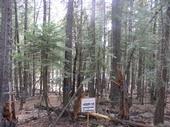- Posted By: Sophie Kolding
- Written by: Sophie Kolding
The journal California Agriculture offers peer-reviewed research and news in agricultural, natural and human resources. Private land owners are able to share their views on rangeland and forest resources. One of the articles in the October-December 2011 issue, Forest and rangeland owners value land for natural amenities and as financial investment, discusses the recent shift away from “production-oriented ownership” of privately owned land, as only a small percentage of landowners earned income from their land. Here is a snippet of the article’s extended abstract:
“Forty-two percent of California's forests and rangelands are privately owned (34 million acres). These lands provide important...
- Posted By: Sophie Kolding
- Written by: Sophie Kolding
The Fritz-Metcalf Photograph Collection is a collection of about 9,000 photographs relating primarily to forestry, conservation, and the lumber industry in California and the United States. Subjects of the photographs include reforestation, forest research, logging operations, logging equipment, and the activities of the University of California's School of Forestry. The photographs were taken from 1906 to 1984, with the bulk of the collection dating between 1910 and 1960. The photographs were taken by Emanuel Fritz, Woodbridge Metcalf, and others.
Emanuel Fritz and Woodbridge Metcalf were both faculty members of the School of Forestry at the University of California, Berkeley. Emanuel Fritz (1886-1988) taught...
- Posted By: Sophie Kolding
- Written by: Michael De Lasaux

The Plumas County Fire Safe Council has coordinated multi-parcel fuel reduction in 13 communities since 2002. The Council began with a county-wide demonstration project in 2002 that treated 62 acres and has since implemented projects on nearly 2,000 acres. As a Natural Resource Advisor in Plumas and Sierra Counties, I have conducted comprehensive monitoring of 7 of the projects.
Coordinated community fuel reduction includes multiple property owners who often have little experience with forest management projects that involve tree thinning to reduce the accumulated fuel hazard. The property owners value their property for aesthetics, wildlife viewing, recreation and other reasons, but they often knew very little about forest...
- Posted By: Richard B Standiford
- Written by: Sarah Yang
Genetic detective work by an international group of researchers may have solved a decades-long mystery of the source of a devastating tree-killing fungus that has hit six of the world's seven continents.
In a study published September 1, in the peer-reviewed journal Phytopathology, California emerged as the top suspect for the pathogen, Seiridium cardinale, that is the cause of cypress canker disease.
It was in California’s San Joaquin Valley in 1928 that S. cardinale was first identified as the culprit causing the disease. The fungus has made its way since to Europe, Asia, New Zealand, Australia, South America and Africa. In many regions, the pathogen has infected and killed up to 95 percent...
- Author: Jaime Adler

Re-posted from UC Berkeley Department of Environmental Science, Policy, and Management.
This image from a Nelder Plot at Blodgett Forest Research Station in the Sierra Nevada mountains is part of a study designed to find out how trees respond to different levels of competition for resources (light, water, and nutrients). The wagon-wheel pattern provides a space-efficient way to experimentally increase tree density as one gets closer to the center of the “spokes.”
The trees in the image are giant sequoia, a species that is particularly sensitive to competition. After only a few years, one can see from the image that trees near the...


